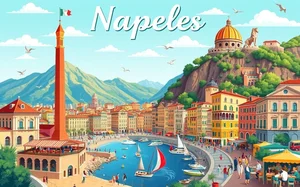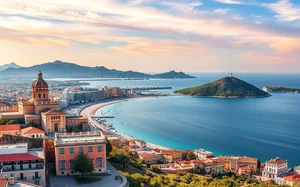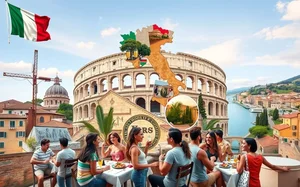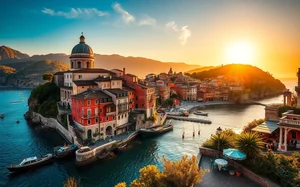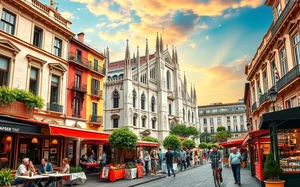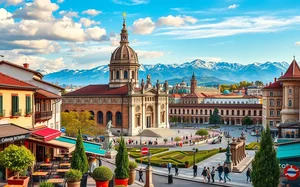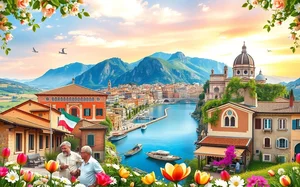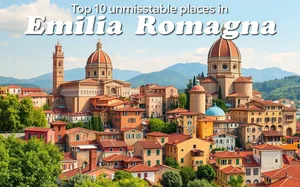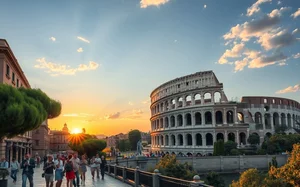Book your experience
Imagine waking up every morning surrounded by towering towers and enchanting gardens, where history intertwines with modern comfort. Sleeping in a castle is not just a dream, but a unique experience that you can have in Italy, home to some of the most fascinating historic homes in Europe. Whether you’re looking for a romantic getaway or an adventure with friends, these majestic residences offer not only a fairytale stay, but also a blast from the past. In this article, we will explore the best options to turn your holiday into a real journey back in time, where every corner tells a story. Get ready to discover how it is possible to sleep like a nobleman, immersed in Italian beauty and culture.
Dream Castles in Italy
Imagine waking up in a majestic home, surrounded by imposing towers and enchanting gardens. Sleeping in a castle in Italy is not just a dream, but a magical experience that can become reality. From north to south, the Bel Paese offers a selection of historic castles, each with its own unique charm and compelling history.
Take for example Neuschwanstein Castle, a jewel of Bavaria that has inspired numerous fairy tales. Or the Fénis Castle in Valle d’Aosta, a perfect example of medieval architecture, with towers and frescoes that tell stories of knights and ladies.
Staying in a castle means immersing yourself in history. Many of these places offer elegant rooms furnished with period furniture, which will make you feel part of a bygone era. Don’t miss the opportunity to stroll through the historic gardens, where the beauty of the flowers and the scent of aromatic herbs create a dreamlike atmosphere.
To make your stay even more special, find out about events and festivals held in the castles. You could participate in a medieval dinner, enjoying typical dishes prepared with ancient recipes, while musicians play old-time melodies.
With careful planning, you can find affordable offers to enjoy this unique experience. Don’t forget to explore the surroundings, where you can discover adventurous trails and cellars producing fine wines, making your stay in a castle an unforgettable adventure.
History and Legends to Discover
Sleeping in a castle is not just a luxury experience, but a journey through time, where every stone tells stories of distant eras. Historic Italian homes, with their fascinating legends, offer a unique opportunity to immerse yourself in a past full of mystery and adventure.
Imagine walking through the corridors of a medieval castle, like Neuschwanstein Castle in the heart of Bavaria, or Fenis Castle in Valle d’Aosta, where legends tell of impossible loves and heroic battles. Every corner can reveal stories of knights and ladies, of ghosts wandering in the halls and of secrets kept in the basement.
Many of these castles offer thematic guided tours, where expert historians reveal intriguing anecdotes and little-known details. Don’t miss the opportunity to visit the Castle of Grinzane Cavour, famous for its connection with Barolo wine and the stories of local nobles.
For an even more immersive experience, attend special events such as historical reenactments, where you can see and experience medieval traditions firsthand. Booking a stay in one of these castles will not only allow you to live in a dream environment, but also to discover stories that will stay with you forever.
Staying in a castle is an opportunity to write your own legend.
Unique Experiences: Medieval Dinners
Imagine walking through the doors of a castle, surrounded by imposing towers and centuries-old walls, to experience a dinner that catapults you back in time. Medieval dinners offer an extraordinary opportunity to savor not only delicious dishes, but also the magical atmosphere of a distant era.
In castles such as Castello di Malaspina in Lunigiana or Castello di Montegufoni in Tuscany, you can enjoy menus inspired by historical recipes, prepared with fresh, local ingredients. The table is adorned with flickering candles and live music provides the backdrop for an experience that awakens the senses.
During dinner, you may be entertained by jesters, musicians and dancers in period costumes, creating an atmosphere that makes every bite an unforgettable experience. Don’t forget to savor the local wines, often specially selected to accompany the culinary specialities, allowing you to savor the terroir of the region.
If you would like to attend a medieval dinner, I recommend booking in advance, as these events are in high demand. Check the castles’ websites to find out available dates and any special offers. This is a unique opportunity to immerse yourself in history and experience a gastronomic adventure that will remain in your heart and memory. Don’t miss the opportunity to transform a simple dinner into a journey into the past!
The Charm of Historic Gardens
Immersing yourself in the historic gardens of a castle in Italy is like taking a journey back in time, among fragrant flowers and well-kept hedges. These green spaces are not just an architectural complement, but represent a true refuge for the soul, where the beauty of nature blends with the grandeur of history.
Think of Bomarzo Castle, with its mysterious gardens and bizarre sculptures, a perfect example of how art and nature can dialogue. Or at Trauttmansdorff Castle in South Tyrol, where the unique microclimate allows the growth of exotic plants and rare flowers, creating an enchanting atmosphere. Walking through shaded avenues and historic fountains is an experience that awakens the senses.
Many of these gardens also offer special events, such as outdoor concerts and guided tours, allowing visitors to discover fascinating stories linked to the noble families who once inhabited these places. Don’t forget to bring a camera - the bright colors and green architecture make for memorable shots.
For botany enthusiasts, it is possible to participate in workshops and gardening courses, completely immersing yourself in the local culture. Staying in a castle and walking through its historic gardens is not just a way to relax, but an opportunity to connect with history and nature in a unique and fascinating way.
Romantic stay between Towers and Suites
Imagine waking up in a suite overlooking a breathtaking view, surrounded by centuries-old towers and well-kept gardens. Sleeping in a castle in Italy is not just an experience, it is a dive into a romantic dream. Every corner of these historic homes tells stories of love and adventures that have their roots in the past.
Castles such as Neuschwanstein Castle or Castelnovo Castle offer elegant suites, complete with period furnishings and modern comforts. Imagine sipping a cup of local wine on your balcony, with the sun setting over the surrounding landscape. The enchanting atmospheres are perfect for couples looking for a romantic getaway.
Many castles offer special packages for couples, which include candlelit dinners in on-site restaurants, where chefs offer traditional local dishes. Don’t forget to explore the gardens, where walking hand in hand can feel like time travel.
To make your stay even more unforgettable, book a guided tour of the historic cellars of the castle, where you can discover the secrets of local viticulture. A stay in a castle is not just an overnight stay, but an experience that promises to remain in your heart forever.
Pack your bags and leave be fascinated by the romantic castles in Italy, where every stay is a story to tell.
Events and Festivals in the Castles
Imagine walking among the ancient walls of a castle, while the air is pervaded by medieval melodies and the scent of local delicacies spreads through the courtyards. In Italy, castles are not only places to visit, but also theaters of events and festivals that bring history and traditions back to life.
Every year, many castles open their doors for extraordinary events. For example, Neuschwanstein Castle, despite being located in Germany, is emulated by Italian castles that organize historical reenactments. The Historical Reenactment Festival at Castel del Monte in Puglia attracts visitors from all over the world, with costumed fights, dances and artisan markets.
Don’t miss the Palio di Siena, where the stage is the city, but the surrounding castles offer exclusive packages to experience the event from a unique perspective. Wine enthusiasts can participate in food and wine festivals, such as the Wine Festival in the Castello di Gabbiano in Tuscany, where tastings and themed dinners make the experience unforgettable.
To participate in these events, it is advisable to book in advance. Many castles offer special packages that include stays, dinners and access to exclusive events. Check official websites for updates on dates and reservations.
Discovering a castle during a festival is a unique way to immerse yourself in Italian culture, creating memories that will remain etched in your heart.
Tips for Convenient Bookings
Sleeping in a castle represents a dream that many wish to realize, but how can we make this experience accessible without compromising the charm of the adventure? Here are some practical tips for convenient bookings.
First, booking in advance can make a big difference. Many castles offer reduced rates for those who book months in advance, especially during off-peak seasons. Furthermore, subscribing to the newsletters of the castles or booking portals can prove advantageous: exclusive offers and promotional packages are often sent.
Another helpful tip is to be flexible on your stay dates. If possible, avoid weekends and holidays, as prices tend to rise. Consider traveling during the week, when the castles are less crowded and fares can be lower.
Don’t forget to check out experiential packages which often include not only accommodation but also dinners, private tours and activities. These packages can prove more convenient than booking separate services.
Finally, use price comparison platforms to find the best deals. Some websites specializing in heritage tourism can offer competitive rates and authentic reviews.
With a little planning and research, your dream of sleeping in a castle can come true without emptying your wallet!
Adventurous Activities Nearby
Sleeping in a castle is not only a dream experience, but it can also be the beginning of unforgettable adventures. The castles of Italy are often surrounded by breathtaking landscapes, historic trails and exploration opportunities that suit every type of traveler.
Imagine waking up in your four-poster bed and immediately being immersed in a world of adventure. You could start your day with a hike in the surrounding woods, such as those surrounding Neuschwanstein Castle, where scenic trails will guide you to spectacular views. Or, for adrenaline lovers, there are activities such as trekking, climbing and mountain biking in the hilly areas of Chianti, near Brolio Castle.
If you prefer an aquatic adventure, many historic homes are located near rivers or lakes, where you can try kayaking or paddleboarding. And don’t forget the bike rides through the vineyards, which offer a perfect combination of exploration and tasting.
- Horseback riding: Discover the Tuscan landscape with horseback riding, starting from castles such as Castello di Casole.
- Guided tours: Take part in guided tours that reveal local history and legends, such as those of the Aragonese Castle in Ischia.
Each castle offers a unique opportunity to combine historic beauty with outdoor adventure, making your stay not only an experience of luxury, but also of excitement and discovery.
Discovering Local Wine in the Castles
Sleeping in a castle is not only a dream experience, but also represents a unique opportunity to discover local wines, often inextricably linked to the history and culture of the area. Many Italian castles are located in renowned wine regions, offering visitors the chance to explore winemaking traditions through exclusive tastings and guided tours.
Imagine waking up in a suite overlooking centuries-old vineyards, and then participating in a wine tasting in the charming courtyard of the castle. Here, you can taste local labels, such as Chianti in Tuscany or Barolo in Piedmont, while an expert guide will tell you fascinating stories linked to each bottle.
Many castles, such as Neuschwanstein Castle or Brolio Castle, offer packages that include visits to historic cellars, allowing you to immerse yourself in the winemaking processes and learn traditional techniques.
To make your experience even more memorable, look for special events, such as harvest parties or wine-paired dinners, where each dish is prepared with fresh, local ingredients, while enhancing the notes of the wines served.
Don’t forget to take home a bottle of your favorite wine, to forever remember this unforgettable adventure among wine towers and hills. Give yourself the luxury of experiencing the history, taste and charm of Italy, all in one magical experience.
Sleeping in a Castle: An Adventure Not to Be Missed
Imagine waking up surrounded by crenellated towers and historic frescoes, as the sun rises behind the Italian hills. Sleeping in a castle is not just an experience, it is a journey through time that immerses you in the history and charm of a bygone era. Every corner of these historic homes tells stories of nobility, battles and legends that are intertwined with the present.
In Italy, you will be able to choose from a wide range of castles offering unique accommodations. From Neuschwanstein Castle in Bavaria to Fenis Castle in Valle d’Aosta, each structure has its own soul and distinctive character. The rooms, often furnished with period furniture, will make you feel like a true lord or lady. Some castles also offer suites with panoramic views that will leave you breathless.
To make your experience even more memorable, many castles offer packages that include medieval dinners, where you can enjoy typical dishes prepared according to ancient recipes, all in a fairytale atmosphere. Don’t forget to explore the historic gardens surrounding these magnificent structures, perfect for a romantic stroll or an unforgettable picnic.
Booking a stay in a castle will allow you to experience a unique adventure, perfect for couples looking for romance or families curious to discover the past. Don’t let this opportunity pass you by: sleeping in a castle is an experience that will remain in your heart forever.


 Architecture and Design
Architecture and Design Cities and Regions
Cities and Regions Culture and History
Culture and History Events and Festivals
Events and Festivals Fashion and Shopping
Fashion and Shopping Food and Wine
Food and Wine Nature and Adventure
Nature and Adventure Unique Experiences
Unique Experiences